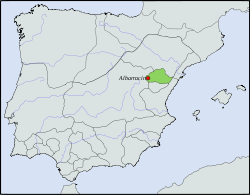Taifa of Albarracín
| Taifa of Albarracín | ||||||||||||
| ||||||||||||
 Taifa Kingdom of Albarracín, c. 1037. | ||||||||||||
| Capital | Albarracín, currently in Teruel, Aragón, Spain. | |||||||||||
| Languages | Arabic, Berber, Mozarabic, Hebrew | |||||||||||
| Religion | Islam, Roman Catholicism, Judaism | |||||||||||
| Government | Monarchy | |||||||||||
| Historical era | Middle Ages | |||||||||||
| • | Downfall of Caliphate of Córdoba | 1012 | ||||||||||
| • | Conquered by the Almoravid dynasty | 1104 | ||||||||||
| Currency | Dirham and Dinar | |||||||||||
| ||||||||||||
The Taifa of Albarracín was a medieval Berber taifa kingdom.[1] The polity existed from 1012 to 1104, and was centered at the city of Albarracín. It was led by the Berber dynasty of the Banu Razin of Houara tribe, which arrived in the peninsula after the conquest of Spain by Tariq ibn Ziyad.
Downfall
In 1167, under the pressure from the ongoing wars between the Almoravid Dynasty and the new invasions of the Almohad Caliphate, the Moorish King Muhammad ibn Mardanis (nicknamed the Robber King), ceded the Taifa of Albarracín to a vassal of Sancho VI of Navarre, a noble from Estella-Lizarra named Pero Ruíz d'Azagra. The title was granted to d'Azagra due to his support of the Navarrese Crown against Alfonso VIII of Castile and Alfonso I of Aragón (Alfonso the Battler).
In 1172, Pero Ruíz d'Azagra managed to consolidate his power over the Señorío making that territory independent of the other Christian kingdoms in the region. In 1190, with the signing of the Borja Accords, between Alfonso II of Aragon and Sancho VI of Navarre, the two monarchs agreed to a defensive pact against Alfonso VIII of Castile which gave official legitimacy to the Sinyoría d'Albarrazín with respect to the two kingdoms.[2]
List of Emirs
Banu Razin
- Hudayl Djalaf 'Izz ad-Dawla: 1012–1045
- Abu Marwan 'Abd al-Malik: 1045–1103
- Yahya Husam ad-Dawla: 1103–1104
See also
References
- ↑ Kennedy, Hugh (2014-06-11). Muslim Spain and Portugal: A Political History of Al-Andalus. Routledge. ISBN 9781317870418.
- ↑ Mariana, Juan de; Sabau y Blanco, José Sabau y Blanco (1818). Historia general de España (in Spanish). 7. Imprenta de Leonardo Nuñez de Vargas. p. 97.
External sites
Coordinates: 40°24′00″N 1°27′00″W / 40.4000°N 1.4500°W